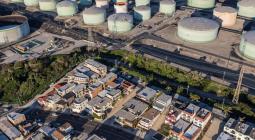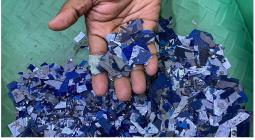Disadvantaged Communities Are Seeing a Boom in Clean Energy Manufacturing, but the Midwest Lags
Private funding to domestically produce electric vehicles and clean energy equipment is largely flowing to “disadvantaged” census tracts, a new analysis shows. The results vary widely by state.
A bonanza of private investments, spurred by federal funding, is helping to fulfill the Biden administration’s promise to lift up historically underserved communities as the nation transitions to a clean energy economy, a new analysis shows.
Since the passage of the 2022 Inflation Reduction Act, which established generous financial incentives for clean energy projects, companies have announced they’ll spend more than $150 billion on new facilities to manufacture electric vehicles, batteries and components for renewable energy in the United States.
More than 40 percent of those announced investments will be spent in “disadvantaged communities”—or DACs—as defined by the White House Council on Environmental Quality, according to an analysis conducted for Inside Climate News by Atlas Public Policy, a Washington D.C.-based research firm. Before the IRA passed, from 2000 to August 2022, just a quarter of the nation’s private investments in clean energy manufacturing went to DAC census tracts, the analysis also found.
While the analysis findings only account for private expenditures, not federal ones, they appear to show that—at some level—President Joe Biden’s goal under the Justice40 Initiative is succeeding at benefiting the communities in most need. Biden created the Justice40 program in 2021 through an executive order that directed federal agencies to deliver at least 40 percent of the “overall benefits” of their environmental and energy spending to “disadvantaged communities that have been historically marginalized and overburdened by pollution and underinvestment.”
The IRA tax credits that are spurring these private investments technically aren’t bound by Justice40, but they nonetheless appear to be producing outcomes that are arguably in alignment with the program, said Tom Taylor, a senior policy analyst for Atlas Public Policy.
“The proportion going to disadvantaged communities after the Inflation Reduction Act passed is really striking,” Taylor said. “It’s remarkable how close it is to the Justice40 number.”
But the analysis also showed that the Midwest is trailing behind other regions when it comes to drawing clean energy manufacturers to disadvantaged communities. The percentage of announced investments in Midwest DACs dropped from 14 percent before the passage of the IRA to roughly 12 percent after it was signed into law.
In interviews with Inside Climate News, state officials, industry representatives, academics and activists said there are likely several explanations for that trend, including demographic differences, cultural and political differences and a failure by some states to attract big manufacturers.
Fewer DACs and Fewer Projects
The city of Flint, Michigan—whose water crisis a decade ago was widely viewed by advocates as a prime example of environmental injustice—is expected to soon get hundreds of new clean energy jobs.
In September, clean energy manufacturer NanoGraf announced it was investing $175 million, with the help of a U.S. Department of Energy grant, to establish a new factory in Flint, where it will produce a silicon-based material for lithium-ion batteries. The company also said it would employ 80 percent of its workforce locally, garnering praise from the city’s mayor, who said he was “thrilled” that Flint residents would have high-paying jobs “for years to come.”
The factory is one of 22 clean energy manufacturing plants across the state that are being built in a disadvantaged community. And yet those projects make up just 21 percent of the total private investments announced for such facilities in Michigan since the IRA passed, the ICN-Atlas Public Policy analysis found. Other state projects include new factories to produce batteries, electric vehicles and various parts for solar farms.
Georgia, in comparison, will see 54 percent of its announced clean energy manufacturing investments in that time period go to a disadvantaged community. That discrepancy, Taylor said, is largely explained by how much of each state is deemed “disadvantaged.”
While roughly 37 percent of Michigan’s census tracts are considered disadvantaged, nearly 60 percent of Georgia’s tracts are deemed as such, federal data shows. In fact, DACs typically make up only 15 to 25 percent of the total census tracts in most Midwestern states, while disadvantaged communities often make up 50 percent or more of the tracts in Southern and Western states, federal data shows.
“That arguably explains what we’re seeing,” Taylor said, since any project will have a less likely chance to be in a DAC in the Midwest than in some of the other regions. Still, he added, that factor doesn’t explain everything.
The size and number of projects in each state matters too.
So far, Taylor said, most Midwestern states haven’t seen many new projects announced since the IRA passed, and even fewer that would be considered large in terms of their cost. So those projects, especially the large ones, have an outsized influence on the overall percentage of funding going to Midwest DACs, he said.
For example, Taylor said, just 10 clean energy manufacturing projects, totalling roughly $770 million, were announced in Minnesota since the IRA—though only four of those projects had exact locations and could be included in the analysis. Similarly, just six such projects were announced in Missouri during that time period, totalling about half a billion dollars in private investments, he added.
But the four Minnesota projects included in the analysis aren’t being built in a disadvantaged community, Taylor said, giving the state a zero in the analysis, even though most of Minnesota’s clean energy manufacturing projects announced before the IRA were located in DACs. Missouri, on the other hand, scored a 97 percent for total investments going to disadvantaged communities because its most expensive projects were all located in DACs, he added.
In that sense, Taylor said, the Midwest has a problem with limited data in some states, which may simply need more time for an accurate state-level trend to emerge. When a state has so few projects, it can reach or surpass the Justice40 benchmark if just one major project goes to a DAC, he said.
Taylor said that regionally, however, there’s enough data to show the Midwest has generally not increased investments going to disadvantaged communities. “It went from 14 percent to 12 percent,” he said, “which is statistically unchanged.”
Different Legacy Industries, Different Cultures
According to industry representatives and academics who spoke with Inside Climate News, the limited data in parts of the Midwest points to another issue: an overall lack of clean energy factories being built in many of the region’s states.
Roopali Phadke, a professor of environmental policy at Macalester College in Minnesota, believes that’s due in part to the states’ histories with different industries.
“When I think of industry jobs, I think of mining and agriculture,” she said. “We in the Upper Midwest here are not part of the Rust Belt. We never think of ourselves that way; we don’t have a lot of legacy industrial facilities like they do in Ohio and Indiana.”
The data appears to back up that assertion. Since the IRA’s passage, the Midwest has received about $45 billion in capital investments for various clean energy factories, the ICN-Atlas Public Policy analysis found, making the region among the most lucrative in the nation in terms of receiving green funding. But the vast majority of that money—$42.8 billion, to be exact—went to just four Rust Belt states: Michigan, Ohio, Illinois and Indiana.
Kevin Pranis, the marketing manager for the Minnesota and North Dakota chapters of the Laborers’ International Union of North America, said he believes cultural and political differences are playing a role, too.
“Minnesota has been a little bit of an island, you know, in preserving labor rights, in preserving environmental protections,” he said, and those factors have made doing business in the state more expensive when compared to some of its neighbors.
Minnesota is also more politically progressive than some other states, especially those in the South, Pranis said. Minnesota Democrats—who have maintained full control of the state government in recent years—have done an excellent job attracting new development of renewable energy plants, such as utility-scale solar farms, but they haven’t done much to attract clean energy manufacturers, he added.
“We don’t do a lot to roll out the red carpet in terms of tax benefits,” he said, noting that many clean energy companies are flocking to Republican-led states that tend to offer more incentives. “It is becoming clear that we would have to change some things in Minnesota to make more of those investments come our way.”
Kevin McKinnon, deputy commissioner of economic development for the Minnesota Department of Employment and Economic Development, which is tasked with attracting business to the state, said in a statement that the agency “has several projects representing many sectors in the pipeline right now” and has created new funding opportunities aimed at attracting clean energy manufacturers to the state and ensuring disadvantaged communities will benefit in the process.
McKinnon said those opportunities include $50 million in state-matched aid for federally-funded manufacturing projects, as well as $2.7 million in state grants to train underrepresented workers for clean energy careers. “Manufacturing clean energy products here in Minnesota is definitely a focus,” he said. “Simultaneously, the process of business attraction and expansion involves a significant amount of time to materialize.”
Pranis said that another issue is that Minnesota has a reputation in industry circles for having a lengthy and difficult environmental review process.
State lawmakers attempted to address that issue by passing a slew of climate-related laws in recent years, including a $2 billion clean energy and environmental spending bill and legislation that aims to streamline the permitting process for clean energy development. But Pranis said those bills only affect the construction of renewable energy systems, not the factories that produce clean energy equipment.
Pranis said he also worries that some “traditional environmental groups” are taking environmental justice arguments too far and slowing down the buildout of clean energy industries, even if certain projects would benefit local residents. “Especially with regard to disadvantaged communities, there is somewhat of a knee-jerk response to industrial development that we see a lot of in Minnesota,” he said.
But Pranis said he’s also uplifted by the emerging coalition in Minnesota, consisting of labor unions, clean energy advocates and environmentalists, which haven’t always been on the same side of the issues but have found ways to work toward shared goals after the IRA passed. That gives him hope that states like Minnesota will find ways to bring more clean energy manufacturers into the state, just like it did with clean energy development.
“We’re working on it,” Pranis said. “It’s also starting, I think, a very important conversation.”
Cover photo: An employee works on new Ford F-150 trucks as they go through the assembly line at the Ford Dearborn Plant on April 11 in Dearborn, Mich. Credit: Bill Pugliano/Getty Images



